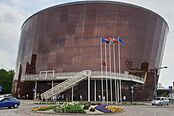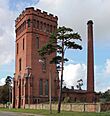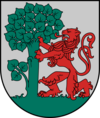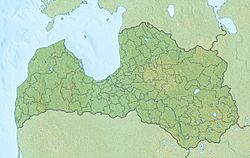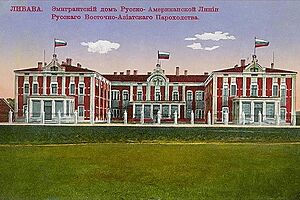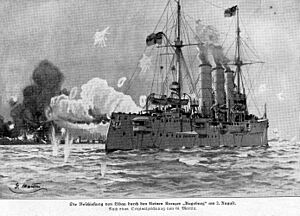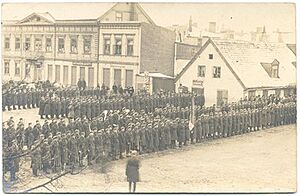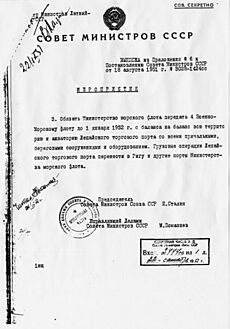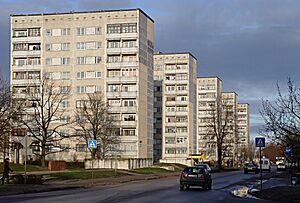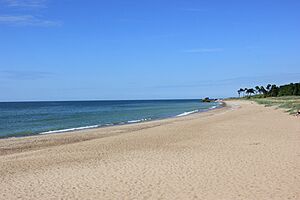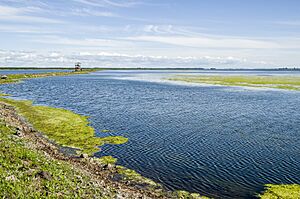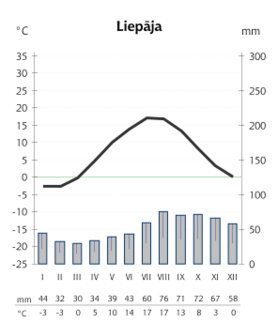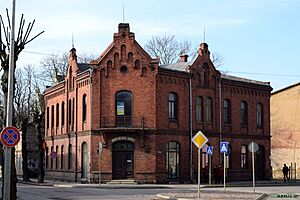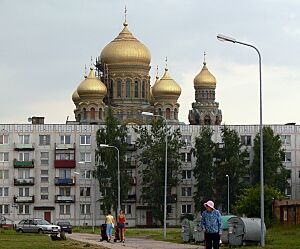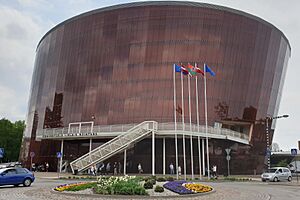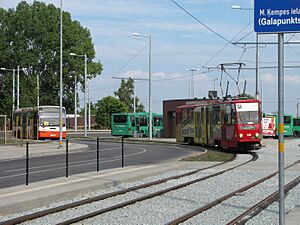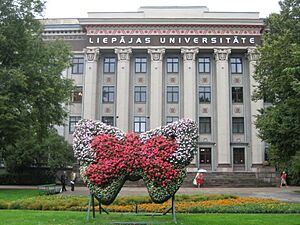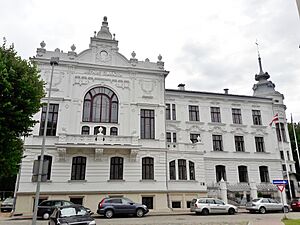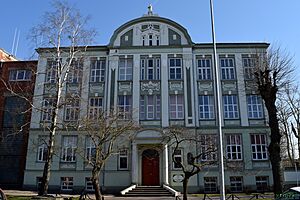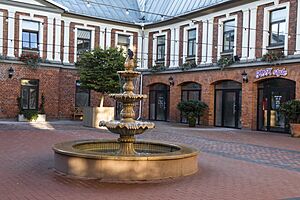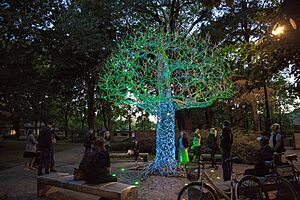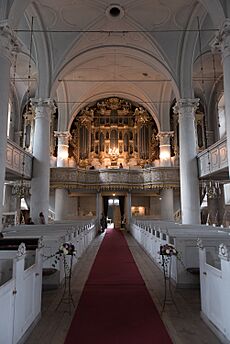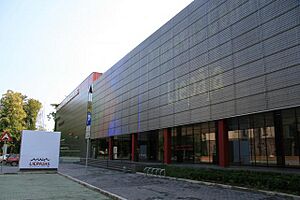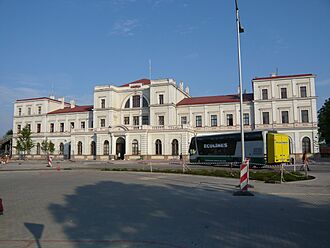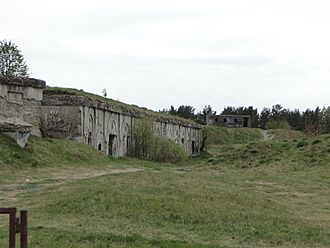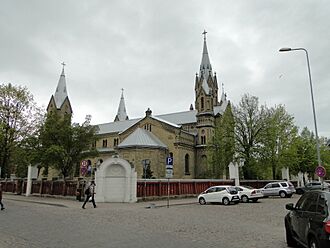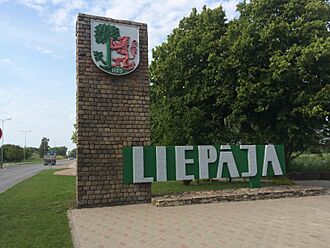Liepāja facts for kids
Quick facts for kids
Liepāja
|
|||||
|---|---|---|---|---|---|
|
State city
|
|||||
|
Aerial View of Liepāja
St Nicholas Naval Cathedral
Town Hall
Great Amber Concert Hall
Karosta Water Tower
|
|||||
|
|||||
| Anthem: Pilsētā, kurā piedzimst vējš "The City where the Wind is Born" |
|||||
| Country | |||||
| Town rights | 1625 | ||||
| Area | |||||
| • State city | Lua error in Module:Wd at line 1,575: attempt to index field 'wikibase' (a nil value). km2 (Formatting error: invalid input when rounding sq mi) | ||||
| • Land | Lua error in Module:Wd at line 1,575: attempt to index field 'wikibase' (a nil value). km2 (Formatting error: invalid input when rounding sq mi) | ||||
| • Water | Expression error: Unexpected < operator. km2 (Formatting error: invalid input when rounding sq mi) | ||||
| Elevation | 14 m (46 ft) | ||||
| Population
(2024)
|
|||||
| • State city | 66,680 | ||||
| • Urban | 100,296 | ||||
| Demonym(s) | Liepājnieki (Latvian) | ||||
| GDP | |||||
| • State city | 1,052,312,000 Euro (2021) | ||||
| • Per capita | 15,565 Euro (2021) | ||||
| Time zone | UTC+2 (EET) | ||||
| • Summer (DST) | UTC+3 (EEST) | ||||
| Postal code |
LV-34(01-13); LV-3414; LV-34(16–17)
|
||||
| Calling code | +371 634 | ||||
| Number of city council members | 15 | ||||
| Climate | Cfb | ||||
Liepāja (pronounced [liepaːja]) is an important city in western Latvia, located right on the Baltic Sea. It is the largest city in the Kurzeme Region and the third-largest in the country after Riga and Daugavpils. Liepāja is known for its ice-free port, which means ships can use it all year round.
In the past, especially in the 19th and early 20th centuries, Liepāja was a popular spot for people to visit the sea. It had a beautiful park, many gardens, and a theatre. Liepāja is also famous in Latvia as the "City where the wind is born," because of the strong and steady sea breeze. There's even a song with the same name, "Latvian: "Pilsētā, kurā piedzimst vējš"", composed by Imants Kalniņš, which has become the city's anthem. This windy reputation grew even stronger when the largest wind farm in Latvia was built nearby.
Liepāja has been chosen as the European Capital of Culture for 2027, which is a big honor!
Contents
- Discovering Liepāja's Name
- Liepāja's Past: A Journey Through Time
- Early Beginnings of Liepāja
- Liepāja in the Livonian Confederation
- Liepāja as Part of the Duchy of Courland
- Liepāja in the Russian Empire
- World War I and Latvian Independence
- Between the World Wars (1920–1940)
- World War II and Soviet Occupation
- Liepāja in the Soviet Era
- Liepāja Today: After Independence
- Liepāja's Location and Natural Beauty
- Liepāja's Buildings and Design
- How Liepāja is Governed
- Liepāja's People and Population
- Liepāja's Economy and Business
- Getting Around Liepāja
- Learning in Liepāja: Schools and Universities
- Liepāja's Vibrant Culture
- Famous People from Liepāja
- Liepāja's Sister Cities
- Images for kids
- See also
Discovering Liepāja's Name
The name Liepāja comes from the Livonian word Liiv, which means "sand". The first time the village of Līva was mentioned in writing was in a treaty from 1253. Later, in 1263, the Teutonic Order founded a town here and called it Libau in German. This name was used until 1920.
The Latvian name Liepāja was first written down in 1649. During the time of the Russian Empire, the city was called Либава (Libava) or Либау (Libau). After World War II, the name Лиепая (Liepaya), which sounds like Liepāja, became common.
Other names for the city include Liepoja in Lithuanian, Lipawa in Polish, and Libow in English.
Liepāja's Past: A Journey Through Time
Early Beginnings of Liepāja
People believe that the first settlement in the area of Liepāja was called Līva. It was founded by Curonian fishermen. In 1263, the Teutonic Order established a village here named Libau. Later, in 1418, the Lithuanians attacked and burned the village.
Liepāja in the Livonian Confederation
During the 15th century, Liepāja became part of an important trade route from Amsterdam to Moscow. However, by 1520, the Līva river became too shallow for ships, and the city's growth slowed down.
Liepāja as Part of the Duchy of Courland

In 1560, Gotthard Kettler, the first Duke of Courland and Semigallia, loaned the area including Libau to Albert, Duke of Prussia. It returned to the Duchy in 1609. During the Livonian War, the Swedes attacked and burned Libau.
In 1625, Duke Friedrich Kettler gave the town city rights. Under Duke Jacob Kettler (1642–1681), Libau became one of Courland's main ports. This was a very successful time for the city. From 1637, ships from Libau and Ventspils (Windau) began exploring and settling distant lands. Duke Jacob was keen on making the economy strong. Metalworking and shipbuilding grew, and trade expanded to countries like Britain, France, the Netherlands, and Portugal.
Between 1697 and 1703, a canal was dug to the sea, and a more modern port was built. In 1701, during the Great Northern War, Charles XII of Sweden captured Libau. Later, in 1710, a terrible plague killed about a third of the people.
Liepāja in the Russian Empire
In 1795, Courland, including Liepāja, became part of the Russian Empire. The city grew very quickly in the 19th century. In 1857, a new railway to Libau was planned, and the port was rebuilt with a lighthouse and breakwaters.
The opening of new railways in the 1870s made Libau a major trade hub for central Russia. By 1900, 7% of all Russian exports passed through Libau. The city became a big port and a popular resort. During this time, city architect Paul Max Bertschy designed many important buildings, shaping the city's look.
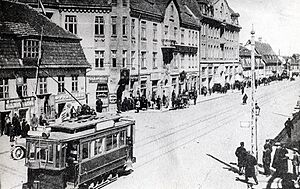
Emperor Alexander III ordered Liepāja to be fortified against possible German attacks. Strong defenses were built around the city, and a large military base was set up in the north. This included coastal forts and military housing. A separate port was dug just for military use, known as Kara Osta (War Port).
In the early 20th century, Libau's port became a key place for immigrants going to the United States and Canada. By 1906, 40,000 migrants used the direct ship service each year. The city's population grew from 10,000 to over 100,000 in about 60 years.
World War I and Latvian Independence
When World War I started, the German cruiser SMS Magdeburg shelled Liepāja. The German Army occupied Liepāja on May 7, 1915. During this time, Liepāja's local government even printed its own money.
After Russia's collapse, Latvia declared independence on November 18, 1918. The Latvian Provisional Government under Kārlis Ulmanis was formed. However, Bolshevik forces advanced, forcing the government to retreat to Liepāja. In April 1919, a German-organized coup forced the Ulmanis government to seek shelter on a steamship in Liepāja port. A British cruiser squadron arrived to support Latvian independence and asked the Germans to leave.
Between the World Wars (1920–1940)
During this time, Liepāja was Latvia's second-largest city. A new bank, the Libau Bank, was founded in 1922. However, business started to shift towards Riga. In 1935, a company called KOD began making light aircraft in Liepāja. Trade with the Soviet Union almost stopped during this period.
World War II and Soviet Occupation
In 1940, the Soviet Union occupied Latvia. Private property was taken over by the state. Many people were arrested and sent to labor camps in Siberia.
In 1941, Liepāja was one of the first cities captured by Nazi Germany. German Nazis and their Latvian helpers almost completely destroyed the local Jewish population, which was about 7,000 people before the war. Most of these terrible killings happened in the dunes north of the city. Very few Jews survived in Liepāja.
The city was heavily damaged during the war, with many buildings and factories destroyed. It was occupied by the Red Army on May 9, 1945. Thousands of Latvians fled to Germany as refugees.
Liepāja in the Soviet Era
In 1949, the Soviet Union carried out another mass deportation to Siberia from Liepāja. The city center was rebuilt in the 1950s. In 1960, the Kurzeme shopping center opened.
During Soviet rule, Liepāja was a closed city. This meant that even local farmers needed a special permit to enter. The Soviet military built a large naval base and nuclear weapon warehouses here. In 1967, the port was completely closed to regular commercial ships. One-third of the city was a Soviet naval base, with 26,000 military staff.
In 1977, Liepāja received an award for its heroic defense against Nazi Germany in 1941. Due to fast population growth, many new apartment buildings were constructed in districts like Dienvidrietumi, Ezerkrasts, and Karosta.
Liepāja Today: After Independence
After Latvia regained independence when the Soviet Union fell, Liepāja worked hard to change from a military city back into a modern port city. The commercial port reopened in 1991, and the last Russian troops left in 1994.
Liepāja now works with many international partners and has 10 twin cities. The city is home to Latvia's largest naval flotilla and important military supply centers. The former closed military town of Karosta is now a northern neighborhood, attracting tourists to its old military sites.
In the 21st century, Liepāja has seen new construction projects. The city's heating system was updated. In 2006, Queen Beatrix of the Netherlands visited Liepāja. In 2010, a new power plant was built.
Liepāja's Location and Natural Beauty
Liepāja is on the coast of the Baltic Sea in southwestern Latvia. It's Latvia's westernmost city. The city sits on a coastal dune area and a flat plain. Liepāja is surrounded by the Dienvidkurzeme Region.
The Trade Channel (Tirdzniecības kanāls) connects the Liepāja Lake to the sea, splitting the city into southern and northern parts. These are often called Vecliepāja (Old Town) and Jaunliepāja (New Town). Further north is Karosta, which is now part of Liepāja. The city's coastline has a long, sandy beach and dunes. About one-third of the city's area is natural, mostly on the edges of the city.
Forests of Liepāja
Liepāja has urban forests covering about 1369 hectares. Most of this is forest, with some swamps, meadows, and sandhills. The city owns most of this forest land. There are five main forest areas, with the largest being the Karosta Forest in the north. The city has many different types of forests due to its unique ground and water conditions.
Liepāja's Waterways
Water covers about 1009 hectares of the city. Liepāja has two lakes, Liepāja and Tosmare, which are important nature sites. There are also rivers like the Vērnieku River and Ālande, and canals like the Tirdzniecības and Karostas canals. The city is right on the Baltic Sea coast.
Liepāja's Climate and Weather
Liepāja's climate is greatly affected by its closeness to the sea. It has a warm-summer humid continental climate. This means summers are not too hot, and winters are not too cold for its northern location. Liepāja has the highest average air temperature in Latvia. It also gets a lot of sunshine, about 1940 hours per year.
Winters often have thaws, so snow cover is usually thin and doesn't last long. The sea around Liepāja rarely freezes. The sea water is warmest in early August.
Liepāja is known for its windy days. The winds mostly come from the west and south. The strongest winds usually happen in autumn and winter. On October 18, 1967, Liepāja recorded the highest wind gust ever in Latvia, at 48 meters per second. The city has the most stormy days in Latvia, averaging 7.9 days per year with very strong winds.
| Climate data for Liepāja (1991–2020 normals, extremes 1895–present) | |||||||||||||
|---|---|---|---|---|---|---|---|---|---|---|---|---|---|
| Month | Jan | Feb | Mar | Apr | May | Jun | Jul | Aug | Sep | Oct | Nov | Dec | Year |
| Record high °C (°F) | 9.0 (48.2) |
15.5 (59.9) |
18.6 (65.5) |
27.0 (80.6) |
30.2 (86.4) |
33.0 (91.4) |
33.7 (92.7) |
35.6 (96.1) |
30.7 (87.3) |
23.0 (73.4) |
15.4 (59.7) |
10.6 (51.1) |
35.6 (96.1) |
| Mean maximum °C (°F) | 5.7 (42.3) |
5.9 (42.6) |
10.8 (51.4) |
20.5 (68.9) |
25.7 (78.3) |
26.9 (80.4) |
29.1 (84.4) |
28.2 (82.8) |
23.2 (73.8) |
17.2 (63.0) |
10.9 (51.6) |
7.2 (45.0) |
30.4 (86.7) |
| Mean daily maximum °C (°F) | 1.1 (34.0) |
1.2 (34.2) |
4.2 (39.6) |
10.3 (50.5) |
15.4 (59.7) |
18.6 (65.5) |
21.6 (70.9) |
21.6 (70.9) |
17.1 (62.8) |
11.3 (52.3) |
6.1 (43.0) |
3.0 (37.4) |
11.0 (51.8) |
| Daily mean °C (°F) | −0.9 (30.4) |
−1.1 (30.0) |
1.3 (34.3) |
6.2 (43.2) |
11.2 (52.2) |
14.8 (58.6) |
17.9 (64.2) |
17.7 (63.9) |
13.6 (56.5) |
8.5 (47.3) |
4.1 (39.4) |
1.1 (34.0) |
7.9 (46.2) |
| Mean daily minimum °C (°F) | −3.4 (25.9) |
−3.8 (25.2) |
−1.8 (28.8) |
2.3 (36.1) |
6.6 (43.9) |
10.7 (51.3) |
13.8 (56.8) |
13.6 (56.5) |
9.9 (49.8) |
5.4 (41.7) |
1.9 (35.4) |
−1.2 (29.8) |
4.5 (40.1) |
| Mean minimum °C (°F) | −14.8 (5.4) |
−13.2 (8.2) |
−9.2 (15.4) |
−3.6 (25.5) |
0.2 (32.4) |
4.5 (40.1) |
8.3 (46.9) |
7.8 (46.0) |
3.3 (37.9) |
−2.2 (28.0) |
−5.2 (22.6) |
−10.2 (13.6) |
−18.0 (−0.4) |
| Record low °C (°F) | −32.9 (−27.2) |
−31.6 (−24.9) |
−23.8 (−10.8) |
−10.1 (13.8) |
−4.3 (24.3) |
0.5 (32.9) |
4.6 (40.3) |
4.6 (40.3) |
−1.7 (28.9) |
−7.3 (18.9) |
−17.5 (0.5) |
−26.0 (−14.8) |
−32.9 (−27.2) |
| Average precipitation mm (inches) | 57.8 (2.28) |
41.9 (1.65) |
37.4 (1.47) |
28.6 (1.13) |
37.5 (1.48) |
50.7 (2.00) |
64.3 (2.53) |
76.3 (3.00) |
74.1 (2.92) |
84.2 (3.31) |
72.7 (2.86) |
67.5 (2.66) |
693.0 (27.28) |
| Average precipitation days (≥ 1.0mm) | 13 | 9 | 9 | 6 | 6 | 7 | 8 | 9 | 10 | 12 | 13 | 13 | 115 |
| Average relative humidity (%) | 87.5 | 86.2 | 82.5 | 76.2 | 75.1 | 78.4 | 78.3 | 78.2 | 80.7 | 83.1 | 86.9 | 87.2 | 81.7 |
| Average dew point °C (°F) | −2 (28) |
−3 (27) |
−2 (28) |
2 (36) |
6 (43) |
10 (50) |
14 (57) |
13 (55) |
10 (50) |
6 (43) |
2 (36) |
−1 (30) |
5 (40) |
| Mean monthly sunshine hours | 41.6 | 71.1 | 148.5 | 223.7 | 300.1 | 302.4 | 309.4 | 264.7 | 187.9 | 113.1 | 40.9 | 25.7 | 2,029.1 |
| Source 1: Latvian Environment, Geology and Meteorology Centre | |||||||||||||
| Source 2: NOAA (precipitation days, humidity 1991-2020), Time and Date (dewpoints, 1985–2015) | |||||||||||||
| Coastal temperature data for Liepāja | |||||||||||||
|---|---|---|---|---|---|---|---|---|---|---|---|---|---|
| Month | Jan | Feb | Mar | Apr | May | Jun | Jul | Aug | Sep | Oct | Nov | Dec | Year |
| Average sea temperature °C (°F) | 4.0 (39.20) |
2.9 (37.22) |
3.5 (38.30) |
5.8 (42.44) |
10.1 (50.18) |
15.4 (59.72) |
19.7 (67.46) |
20.0 (68.00) |
16.5 (61.70) |
12.9 (55.22) |
10.3 (50.54) |
6.5 (43.70) |
10.6 (51.14) |
| Source 1: Seatemperature.net | |||||||||||||
Liepāja's Neighborhoods and Nearby Cities
|
Liepāja is divided into several districts:
|
Some areas just outside the city are considered suburbs:
|
The closest city to Liepāja is Grobiņa, about 10 km away. Other important cities nearby are Klaipėda in Lithuania (about 110 km south) and Ventspils (about 115 km north). The capital of Latvia, Riga, is about 200 km to the east. The closest point across the Baltic Sea is the Swedish island of Gotland, about 160 km northwest.
Liepāja's Buildings and Design
Liepāja has buildings from many different time periods. You can see classical wooden houses from the 17th century, beautiful brick buildings, and Art Nouveau styles from the late 19th and early 20th centuries. There are also buildings from the Soviet era and modern designs. Many buildings were destroyed during World War II, especially in the city center.
Early Architecture in Liepāja
Liepāja's architecture first really flourished in the 17th and 18th centuries. Wealthier people built houses in styles like Baroque and Classicism. The oldest type of house in Liepāja is a wooden log house with a steep tiled roof. You can see these on Kungu Street. The building at 24 Kungu Street was visited by Tsar Peter I of Russia in 1697, and the one next door at 26 Kungu Street was visited by King Charles XII of Sweden in 1700.
After the Trade Canal was dug in 1703, the city grew. Wooden warehouses were built near the port. In 1848, most of the city's buildings were still made of wood. The most impressive building from the 18th century is the Holy Trinity Cathedral.
Paul Max Bertschy's Influence
The city changed a lot with the building of new roads and railways in the mid-1800s. In 1871, Paul Max Bertschy became the city's first architect. Many of Liepāja's historic buildings were designed by him. His work includes factories, mansions, apartment buildings, the hospital, and even the St. Anne's Church. His red brick buildings are especially famous.
Art Nouveau Style in Liepāja
Liepāja has many examples of the Art Nouveau architectural style, more than many other European cities. Graudu Street is almost entirely filled with Art Nouveau buildings. Most of them are in a simple, elegant style called Northern National Romanticism. Many architects, including Paul Max Bertchy, designed these beautiful buildings.
Karosta's Unique Military Architecture
In the northern part of Liepāja, the Karosta complex was built by Russian military architects. It looks very different from the rest of the city. Karosta is a great example of a military complex in Latvian history. The Orthodox cathedral is a central building there. The area also has officers' housing and a unique system of fortifications with underground passages. Some of these fortifications were blown up during World War I.
Buildings from the Soviet Era
After World War II, much of Liepāja's city center was destroyed. New plans were made following Soviet architectural rules. Public buildings were designed to be large and impressive. The building for the University of Liepāja was built in 1957. The Kurzeme department store had large windows. Because Liepāja was a closed military city, construction was slow until the 1970s, when new factories and residential areas like Ezerkrasts were built.
Modern Architecture in Liepāja
After Latvia became independent again, new buildings appeared. These include an ice rink, a Catholic monastery, and new market halls. The most famous modern building is the Great Amber Concert Hall. New buildings use modern materials and focus on practical design.
Monuments and Museums to Explore
Liepāja has many monuments and memorials. These include:
- Monument to sailors and fishermen lost at sea (1977)
- Monument to the Defenders of Liepāja in 1941
- Monument to 1919 Freedom Fighters
- The Amber clock
You can also visit several museums:
- The Liepāja Museum
- Liepāja Museum "Liepāja during the occupational regimes" (about Soviet and Nazi times)
- Museum "History of Liepāja Community of Jews"
- Museum "Karosta Prison"
Churches of Liepāja
Liepāja has many churches, mostly Protestant (Lutheran). The Holy Trinity Cathedral is the main Lutheran church. There are also several Baptist churches.
Because of its importance in the Russian Empire, several Russian Orthodox churches were built, mainly for the Russian-speaking population. The St. Joseph Cathedral is the main Catholic church.
Famous Buildings to See
- Rose Square (Latvian: Rožu laukums)
- Swan Pond (part of the old Līva river)
- Peter The Great house – the oldest house in Liepāja
- Great Amber Concert Hall
- Pētertirgus – the Central Market
- Liepājas teatris (Liepāja Theatre)
- 1st Latvian Rock Café
How Liepāja is Governed
The Liepāja City Council runs the city. It has fourteen members and a mayor. Voters choose a new government every four years. The Council chooses the Mayor and two Deputy Mayors from its members. They also appoint members to committees that handle finances, city development, social affairs, education, and culture. In 2022, Liepāja's budget was 104 million euros. The Liepāja Party has been very popular in recent years.
Liepāja's People and Population
| Historical population | ||
|---|---|---|
| Year | Pop. | ±% |
| 1638 | 1,000 | — |
| 1800 | 4,500 | +350.0% |
| 1840 | 11,000 | +144.4% |
| 1881 | 29,600 | +169.1% |
| 1897 | 64,500 | +117.9% |
| 1907 | 81,000 | +25.6% |
| 1914 | 94,000 | +16.0% |
| 1921 | 51,600 | −45.1% |
| 1940 | 52,900 | +2.5% |
| 1950 | 64,200 | +21.4% |
| 1959 | 71,000 | +10.6% |
| 1970 | 92,900 | +30.8% |
| 1975 | 100,000 | +7.6% |
| 1989 | 114,500 | +14.5% |
| 1995 | 100,300 | −12.4% |
| 2000 | 89,100 | −11.2% |
| 2007 | 85,300 | −4.3% |
| 2011 | 83,400 | −2.2% |
| 2019 | 68,945 | −17.3% |
Liepāja has always had a mix of different cultures, which has shaped its social life and economy. The city's population grew quickly after 1817, reaching 29,600 by 1881. Before World War I, the population grew almost tenfold in 50 years. During the Soviet occupation, the population doubled, but growth was limited because of the closed military port.
Before World War I, many Baltic Germans lived here. Before World War II, there was a large Jewish population. During Soviet times, the number of Russians increased. The percentage of Latvians grew until World War II, but then decreased.
In 2019, Liepāja had 68,945 people, making it Latvia's third-largest city. The population has decreased since Soviet troops left in 1994. Many ethnic Russians moved to Russia. Also, people have moved to other European countries since Latvia joined the EU in 2004, and birth rates are lower. However, in 2018, more people started moving to Liepāja than leaving, which is a positive sign.
Religious Communities in Liepāja
Liepāja has many churches. Like in other parts of western Latvia, Protestant churches, especially Lutheran ones, are most common. The Holy Trinity Cathedral is the seat of the Lutheran Bishop of Liepāja. There are also four Baptist churches.
Because Liepāja was important during the Russian Empire, several Russian Orthodox churches were built. These churches mainly serve the Russian-speaking community.
The Catholic faith is represented by the St. Joseph Cathedral, which is the main Catholic church in the area. Other Christian groups like Old Ritualists, Adventists, and Jehovah's Witnesses also have churches here.
Liepāja's Economy and Business

After the Soviet Union's economy collapsed, Liepāja faced challenges with its old infrastructure. To help businesses grow, the Liepāja Special Economic Zone (Liepāja SEZ) was created in 1997. This zone aims to develop business, manufacturing, shipping, and trade, and to attract investments to create new jobs.
After Latvia joined the European Union in 2004, some companies faced tough competition. In 2013, a large steel company, Liepājas Metalurgs, went bankrupt, which was a big economic blow. Today, the city's economy is mainly driven by the Liepāja Special Economic Zone, its Trade Port, and the companies located there. Top companies in 2021 included TOLMETS, AE Partner, and Jensen Metal.
Getting Around Liepāja
Liepāja has a public transport system with 31 bus lines and one tram line. The tram line is 7 kilometers long and is the oldest electric tram line in the Baltic states, opened in 1899. It is run by the city company Liepājas tramvajs. In 2013, the tram line was extended.
Liepāja has direct bus connections to Riga, Riga International Airport, Ventspils, Jelgava, and Klaipėda.
The city also has a railway connection to Jelgava and Riga, linking it to Latvia's railway network. The railway is important for moving cargo to the port. Two main highways, the A9 and A11, connect Liepāja to the rest of the country. The city also has Liepāja International Airport, one of Latvia's three international airports, used for private and military flights.
The Port of Liepāja is large and has three main parts. The Winter harbor is for smaller fishing and cargo ships. The main port area can handle large ships and ferries. The Karosta harbor, once a military port, is now used for ship repairs and other commercial activities. Liepāja also welcomes yachts and other leisure boats.
Learning in Liepāja: Schools and Universities
History of Education in Liepāja
Schools existed in Liepāja even before it became a city in 1625. The city was responsible for maintaining schools, and both German and Curonian children were encouraged to attend. The first school started with one class and grew over time. In 1806, it became the county's highest school. Famous Latvians like Krišjānis Valdemārs studied there.
In 1861, a maritime class opened, which later became the Liepāja Maritime School. The first high school for girls opened in 1871. During the late 1800s, schools became more Russian, but Latvian was still taught. Schools with only Latvian as the language appeared after Latvia gained independence.
Between the World Wars, Liepāja had three secondary schools, 25 primary schools, and many technical and art schools. In 1919, the city library opened a special section just for children, the first in Latvia.
After World War II, Liepāja became home to the Liepāja Pedagogical Institute, a maritime school, a medical school, and many other educational institutions.
Education Today in Liepāja
Liepāja offers many educational opportunities. In 2022, the city had 21 kindergartens, twelve general education schools, and two private schools. There are also two music schools and two boarding schools.
For children and youth, there are 8 municipal institutions offering interest education, such as the Children and Youth Centre, sports schools, and an Art and Creation Centre. The Liepāja Central Library has six branches and a large collection of books.
Liepāja also has several higher education institutions:
- University of Liepāja
- Riga Technical University Liepāja branch
- Rīga Stradiņš University Liepāja branch
- Baltic International Academy Liepāja branch
- Turība University Liepāja branch
- Liepāja Maritime College
- Liepāja Medical College
- Liepāja Applied Art School
Liepāja's Vibrant Culture
Liepāja is known as a city with rich cultural and historical traditions. It plays a very important role in Latvia's cultural scene. The city has state and city-run cultural institutions, as well as artistic groups from the University of Liepāja. Liepāja has a strong history of performing arts, crafts, and folk art. Cultural tourism and creative industries are growing here.
Liepāja competed to become the European Capital of Culture (ECOC) in 2014, but Riga was chosen. However, on May 10, 2022, Liepāja was successfully awarded the status for 2027!
Liepāja's Symbols and Identity
Liepāja has three official symbols: a coat of arms, a flag, and an anthem. The coat of arms was adopted in 1625 and shows the lion of Courland leaning on a linden tree. The flag has the coat of arms in the center, with red on top and green on the bottom.
The city's anthem, The City where the Wind is Born (Pilsētā, kurā piedzimst vējš), was approved in 1999. Imants Kalniņš wrote this song in 1973, dedicating it to Liepāja. It quickly became an unofficial anthem.
Liepāja also has its own special dish called 'Liepājas menciņi'. It's made with smoked cod, potatoes, onions, and dill in cream, cooked in a ceramic pot. This recipe comes from an old tradition of coastal people eating dried fish.
Music Scene in Liepāja
Liepāja is often called the music capital of Latvia. It is home to the Liepāja Symphony Orchestra, which is the oldest orchestra in the Baltic States and the only professional orchestra in Latvia outside Riga.
Many famous bands like Līvi, Credo, and Tumsa come from Liepāja. Composers like Zigmars Liepiņš are also from here. The city hosts music festivals such as Summer Sound and the International Organ Music Festival.
Art and Visuals in Liepāja
Liepāja has a long and rich art history. The oldest artwork is the altar of St Anne's Church from 1697. The organ of the Holy Trinity Cathedral is a significant 18th-century artwork.
The city has many sculptures and memorials. You can find monuments to sailors and fishermen, and to the poet Mirdza Ķempe. The words of the Liepāja anthem are even reproduced in bronze sculptures along Kūrmāja Prospect.
Theatre in Liepāja
The Liepāja Latvian Dramatic Society was founded in 1907. This led to the creation of the Liepāja Theatre, which is the oldest professional Latvian theatre still running today.
Sports in Liepāja
In 1998, Liepāja opened the first ice hockey rink built in independent Latvia. The local team, HK Liepājas Metalurgs, won many Latvian championships. After this team stopped, a new one, HK Liepāja, was founded and won the championship in 2015–16.
The city also has a football team, FK Liepāja, which became Latvian champions in 2015. Their home is the Daugava Stadium. Liepāja also has a professional basketball team.
In 2008, the Liepāja Olympic Centre, a modern sports and cultural complex, opened. Liepāja often hosts big sports events, like basketball championships and the European Rally Championship stage "Rally Liepāja".
Media in Liepāja
Liepāja has a regional newspaper called Kurzemes vārds and a regional TV channel, TV Kurzeme. There are also several local internet portals. The city has a wireless video monitoring system.
Famous People from Liepāja
- Woldemar Kernig (1840—1917) — Russian and German neurologist;
- Miķelis Valters (1874—1968) — politician, first Latvian Minister of Interior;
- Lina Stern (1878—1968) — biochemist;
- Yanka Maur (1900—1971) — Belarusian writer;
- Augusts Annuss (1893—1984) — painter;
- Eduard Tisse (1897—1961) — cameraman;
- Jacob Klein (1899–1978) – Russian-American Jewish philosopher;
- Valdemārs Baumanis (1905—1992) — basketball coach;
- Balys Dvarionas (1905—1972) — Lithuanian composer;
- Mirdza Ķempe (1907—1974) — poet;
- Arvīds Jansons (1914—1984) — conductor;
- Tālivaldis Ķeniņš (1919—2008) — composer;
- Morris Halle (1923—2018) — Latvian-American Jewish linguist;
- George D. Schwab (1931) — American political scientist and Holocaust survivor;
- Kirovs Lipmans (1940) — businessman;
- Teofils Biķis (1950—2000) — pianist;
- Zigmars Liepiņš (1952) — composer:
- Jānis Vanags (1958) — Archbishop of Riga;
- Laila Pakalniņa (1962) — film director;
- Igo (1962) — singer and composer;
- Mārtiņš Freimanis (1977—2011) — musician and actor;
- Konstantin Konstantinovs (1978—2018) — Latvian-Russian powerlifter;
- Māris Verpakovskis (1979) — football player;
- Romāns Miloslavskis (1983) — swimmer and politician;
- Mareks Mejeris (1991) – basketball player;
- Anastasija Sevastova (1990) — tennis player;
- Kristaps Porziņģis (1995) — basketball player;
- Rūdolfs Balcers (1997) — ice hockey player
Liepāja's Sister Cities
Liepāja is connected with these cities around the world:
Images for kids
See also
 In Spanish: Liepāja para niños
In Spanish: Liepāja para niños





